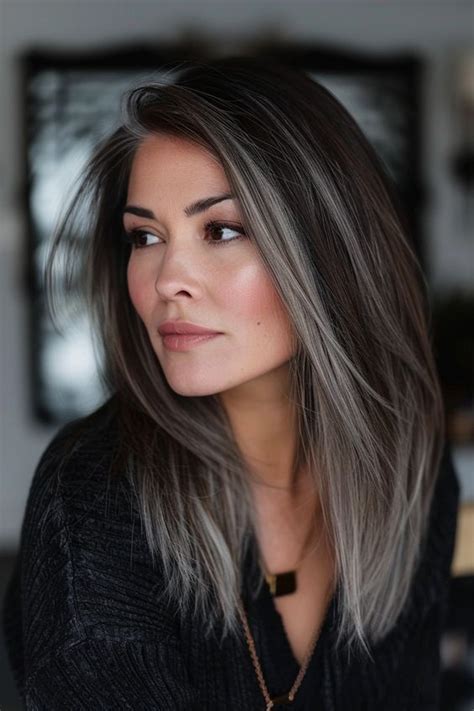As society embraces inclusivity and acceptance, gray hair is no longer synonymous with aging or dullness. It’s now a vibrant trend that celebrates the beauty of natural texture. With the right inspiration and techniques, you can transform your gray locks into a stunning masterpiece.

Shades of Silver:
1. Ash Gray: A cool, metallic shade that exudes sophistication and elegance. (Figure 1)
2. Pearl Gray: A soft, iridescent hue that adds a subtle shimmer to your hair. (Figure 2)
3. Platinum Gray: A striking, high-contrast shade that turns heads with its icy radiance. (Figure 3)
Blends and Balayage:
4. Gray Ombre: A gradual transition from darker roots to lighter gray ends, creating a seamless and elegant effect. (Figure 4)
5. Gray Balayage: A freehand technique that paints strands of gray throughout your hair for a natural and dimensional look. (Figure 5)
Highlights and Lowlights:
6. Gray with Blonde Highlights: A blend of gray and blonde creates a luminous and sun-kissed effect. (Figure 6)
7. Gray with Purple Lowlights: A bold and alluring combination that adds depth and intrigue to your gray hair. (Figure 7)
Pastel Hues:
8. Lavender Gray: A dreamy blend of gray and lavender that adds a touch of whimsy and femininity. (Figure 8)
9. Rose Gray: A soft and romantic shade that complements pink undertones and creates a flattering blush effect. (Figure 9)
Artificial Pigments:
10. Gunmetal Gray: A deep, smoky hue that mimics the metallic finish of firearms. (Figure 10)
11. Silver Fox Gray: A classic and timeless shade that resembles the sleek and sophisticated silver fox fur. (Figure 11)
Blues and Greens:
12. Blue-Gray: A cool and refreshing shade that adds a touch of icy depth to your gray hair. (Figure 12)
13. Green-Gray: A subtle and unexpected blend that adds a touch of nature to your silver locks. (Figure 13)
Unique and Edgy:
14. Salt and Pepper Gray: A blend of gray and black hair that creates a textured and edgy look. (Figure 14)
15. Gray with Reverse Balayage: A twist on traditional balayage, where the gray is concentrated at the roots for a bold and striking effect. (Figure 15)
Common Mistakes to Avoid:
- Over-bleaching: Gray hair requires less bleach to achieve the desired shade, so avoid excessive processing to prevent damage.
- Using the wrong toner: Choose a toner specifically designed for gray hair to avoid unwanted yellow tones.
- Neglecting hair care: Gray hair tends to be drier, so regular conditioning and moisturizing are essential for maintaining its health.
- Unrealistic expectations: Gray hair is not always uniform in color, and some strands may naturally be darker or lighter than others. Embrace the natural variation.
Step-by-Step Approach to Gray Hair Coloring:
- Consult with a professional hairstylist to determine the best shade and technique for your hair type and skin tone.
- Protect your hair with a pre-treatment serum or hair mask to prevent damage.
- Use a high-quality bleach or lightener specially formulated for gray hair.
- Apply the bleach or lightener according to the manufacturer’s instructions, minimizing processing time.
- Rinse out the bleach or lightener thoroughly and apply a toner to achieve the desired shade.
- Condition your hair deeply to restore moisture and prevent dryness.
- Style your gray hair as desired, using products designed for color-treated hair.
Conclusion
Embracing your gray hair can be a liberating and empowering experience. With the endless possibilities of shades and techniques available, you can create a truly unique and flattering look that celebrates the beauty of your natural color. Remember to prioritize hair care and consult with a professional to achieve the best results possible. Embrace the silver revolution and let your gray hair shine.
